Phở is a popular dish among the Vietnamese people. Vietnamese Pho is classified as “common” but you may not know that. Phở is the most famous Vietnamese dish for international tourists. So what makes Vietnamese Pho so attractive, let’s find out.
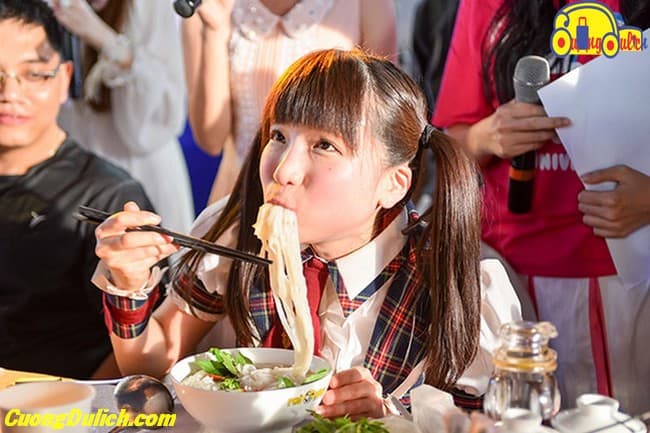
What is Phở?
Phở is a traditional dish of Vietnam, also considered one of the most characteristic dishes of Vietnamese cuisine. Phở is usually served as a breakfast dish or for dinner. (In Vietnam, Phở is also used figuratively to refer to extramarital affairs)
Main ingredients in a bowl of Phở
The main ingredients of Phở are flat rice noodles and broth (or broth in the Southern style) with thinly sliced beef. Originally, only well-cooked beef Phở with all parts “well-done-flank-brisket-tripe-fat” were accepted, later, diners also accepted rare beef Phở, chicken Phở, pork Phở, shrimp Phở… Going further, there were restaurants experimenting with duck meat, goose meat, but not very successful.
- “Flat rice noodles”, traditionally made from rice flour, flattened into thin sheets and cut into strands.
- The broth (or broth) is generally made by simmering (northern people call it stewing) beef bones, meat used for Phở is beef or chicken, dried squid and spices including cinnamon, star anise, ginger, coriander seeds, cloves, dried shallots, baby shrimp, dried ginseng, oxtail, sawtooth herb (culantro),… The specific recipe for each type of broth for each Phở brand is kept quite secret.
- It also comes with condiments such as: hoisin sauce, pepper, lime, fish sauce, chili,… These condiments are added according to each person’s taste. In the southern provinces of Vietnam, Phở is served with additional garnishes called herbs such as onions, bean sprouts, and various herbs like cilantro, basil, among which culantro is a characteristic leaf of Phở.
Tips for eating Phở
Phở must always be eaten hot to be delicious, however, to have a delicious bowl of Phở also depends on the experience and traditional secrets of Phở cooking. In Hanoi, it is popular to eat Phở with “quẩy” (southern people call it “giò cháo quẩy”) while people in Saigon only eat “quẩy” with porridge.
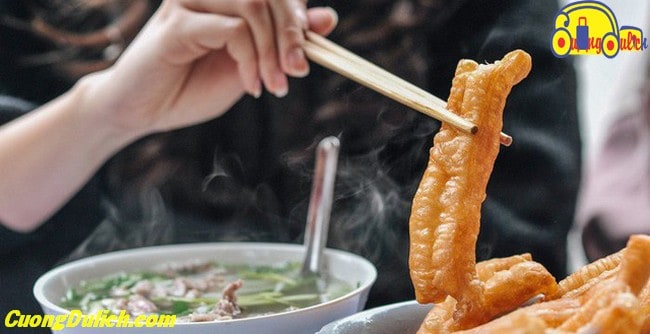
Today, pho has different preparation methods and flavors. In Vietnam, there are different names to distinguish them: Pho Bac (in the North), pho Hue (in the Central region), and pho Sai Gon (in the South). Typically, pho from the North is characterized by a salty taste, while in the South it is sweeter and has more herbs. The rice noodles in the South are smaller than in the North.
Origin of Pho in Vietnam
Pho originated from Northern Vietnam, spreading to the Central and Southern regions in the 1950s, after the French failure in Indochina and the division of Vietnam into two regions. Vietnamese people from the North migrated to the South in 1954, bringing pho with them, and pho began to show differences. However, a common rule is that traditional pho restaurants always have a single-word name, usually the name of the owner, such as Pho Hoa, Pho Quyen…
The emigration of Vietnamese people during the post-Vietnam War period made pho known in many places around the world, especially in Western countries. There are many pho restaurants in the United States, France, Australia, and Canada. Other Vietnamese people also brought pho to countries in the Soviet bloc, including Russia, Poland, and the Czech Republic… In the United States alone, unofficial statistics in 2005 showed that the revenue of Vietnamese pho restaurants nationwide reached about 500 million USD per year. Until now, originating in Vietnam, pho has become a famous dish in many countries around the world.
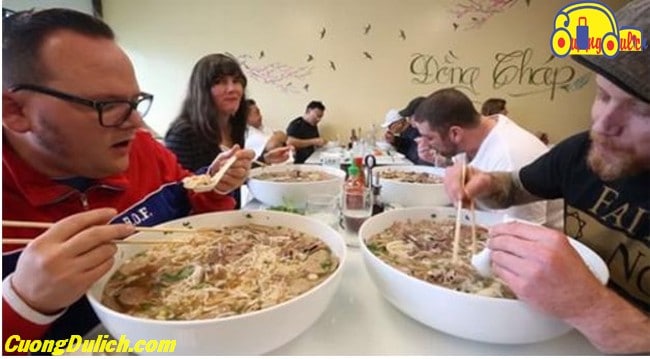
Pho has entered poetry
Writer Thach Lam wrote in the book “Hanoi with six streets”: “Pho is a special gift of Hanoi, not only Hanoi has it, but it’s delicious only in Hanoi”. Delicious pho must be “traditional”, cooked with beef, “clear and sweet broth, soft but not mushy noodles, crispy fat meat instead of tough, with lime, chili, and onions, fresh herbs, northern pepper, strong kumquat juice, and a hint of cà cuống, light as a suspicion”. In the 1940s, pho was very popular in Hanoi: “It was the daily food gift for everyone, especially officials and boatmen. People ate pho for breakfast, lunch, and dinner…”. Photo: Pho bowl from Nam Dinh.
The most famous pho brands in Hanoi today
Hanoi cuisine has many dishes, but when mentioned first, it must be pho. Pho is like a representative symbol of Hanoi cuisine. Hanoi pho has the genuine sweetness of beef bones, the aroma of perfectly cooked tender meat, clear broth, thin and soft noodles.
Square Pho
Square Pho – a name that sounds strange and intriguing. Square, it hints at the perfection of 4 important elements: flavor, service, cleanliness, and price. Square, when translated into English, also means a square, a lively gathering place for everyone. It is also the aspiration for “Authentic Hanoi Pho for discerning eaters” of the owner who was born into a Hanoi family with a tradition of making pho.
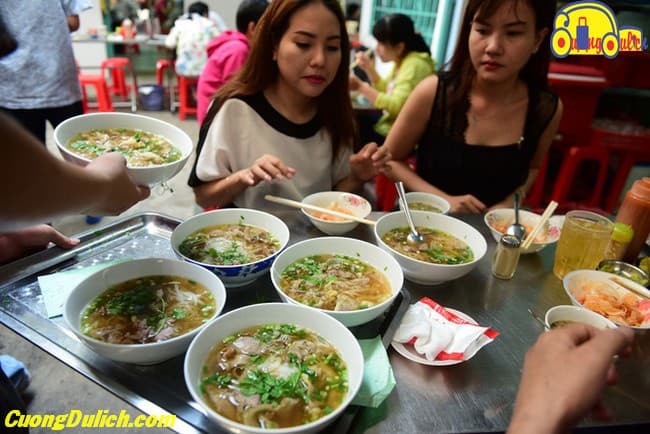
Aside from 20 delicious pho dishes priced from 20,000 – 28,000 VND/bowl, customers are also served drinks, can listen to music, watch the news, and enjoy other services.
Address: 44 Ngo Thi Nham, District Hai Ba Trung, Hanoi.
Pho Thin
One of the most famous pho restaurants in Hanoi. The space is quite cramped but always crowded with customers from early morning. To have a bowl of pho here, diners often have to wait for a while, then pay and receive the pho bowl before finding a table to sit. The harmony between the broth and noodles, between the meat and the pho has created the unique taste of Pho Thin that no other dish has.
Address: 13 Lo Duc, District Hai Ba Trung, Hanoi
Pho Nho
The name Nho originates from a Vietnamese overseas who loves Hanoi pho and came to enjoy and named the restaurant: “Eat and remember forever…”. From then on, Pho Nho became a brand, a familiar name to many discerning diners. The chewy noodles, tender and sweet meat, light fragrance with a hint of sharpness from the thin ironed spring onions, the spicy taste of fresh chili slices, the gentle aroma of fresh and tender beef. Eating a bowl of pho is like enjoying a work of art. Is Pho Nho delicious due to its own secret recipe or the dedication of the restaurant owner? Could it be the reasons that brought Pho Nho to second place in the Hanoi Pho competition?
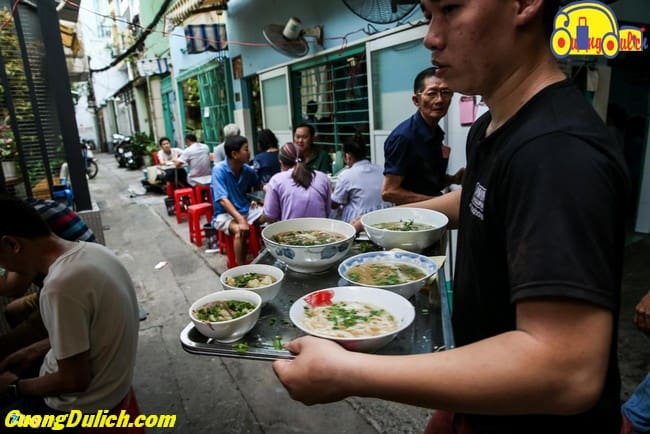
Address: Pho Nho – 27A, Huynh Thuc Khang.
Traditional Pho – Bat Dan
The traditional pho restaurant at 49 Bat Dan has been around since the 1960s. After nearly half a century, the place remains the same, almost unchanged. Back in those days, queuing up for pho was a familiar sight in Hanoi. It has become a memory deeply ingrained in the minds of many generations. The authentic Hanoi pho served here does not come with bean sprouts, basil, sawtooth herb, or culantro like in Saigon. The seasoning can be added with spicy chili sauce and lime. The broth is perfectly seasoned so customers don’t need to add fish sauce. The noodles are thin, the meat is tender and flavorful, but what stands out is the tendon, which is cooked to a soft texture that melts in your mouth.
Address: 49 Bat Dan Street, Hoan Kiem District, Hanoi.
Pho 24
Pho 24 has become a well-known pho brand not only domestically but also internationally. Tourists often enjoy pho here because of the cleanliness and professional service. Pho 24 restaurants are designed with consistent standards in terms of interior and pho preparation methods. Pho 24 offers a variety of choices: beef pho, rare beef pho, well-done flank pho, brisket pho, cooked beef pho, or chicken and young egg pho. Additionally, there are many nutritious drinks made from fresh fruits.
Address: 45 Huynh Thuc Khang, Dong Da District, Hanoi.
